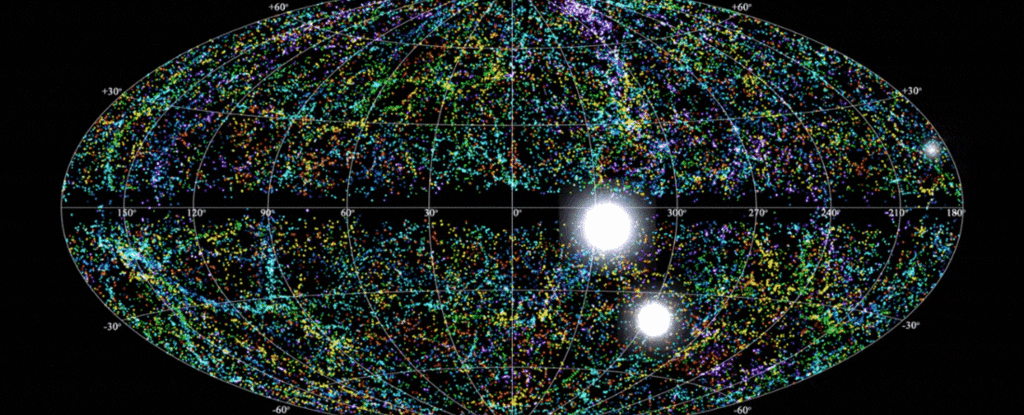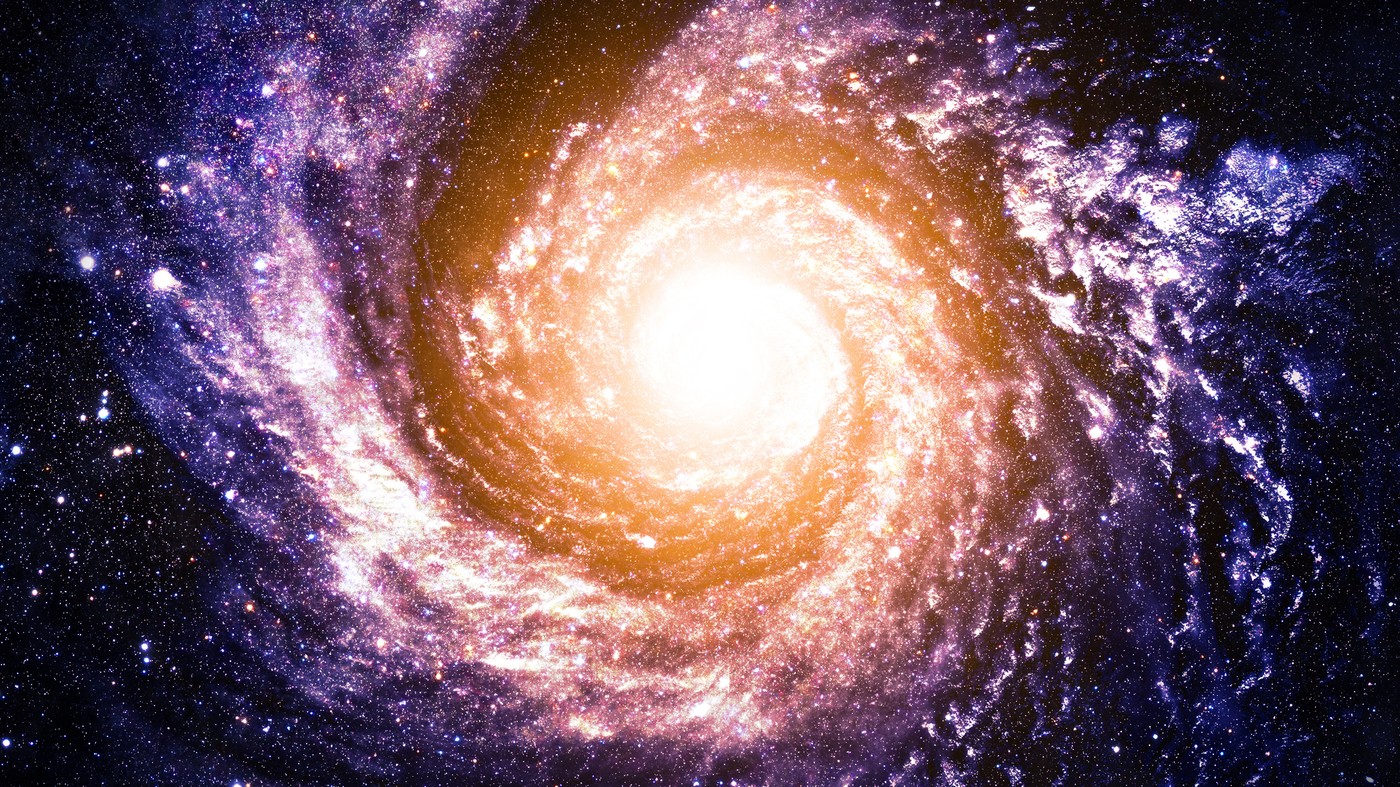
(NRAO Outreach/Vimeo)
There are many things in the Universe we are yet to understand. It's a big old machine just churning out mysteries, and we tiny specks crawling on the surface of a small blue dot are doing our darnedest to unravel them.
Recently, news emerged about one of the most tantalising mysteries. For the first time, a fast radio burst (FRB) has been detected emitting in a pattern - a 16-day cycle, with four days of intermittent bursts and 12 days of silence.
We still don't know what causes these extremely powerful, millisecond blasts of radio waves from up to billions of light-years away. Most of them haven't been detected repeating, most of them are wildly unpredictable, and only five out of over 100 have been traced to a source galaxy.
It's proven extremely tricky to find a cosmic phenomenon that fits the profile of FRBs. Violent, highly magnetised neutron stars called magnetars are pretty close, but there's some doubt as to whether they can emit the nova-scale energies detected in fast radio bursts.
But the absence of a solid explanation thus far doesn't mean we should automatically turn to aliens, as so many headlines have done. When unusual cosmic phenomena appear, rampant speculation arrives at this suggestion all too quickly.
"Invoking aliens has become too systematic, too easy, and too sensationalist a way to get the public's attention ... [It] reminds me of the way we used to invoke gods," planetary scientist and astrobiologist Charley Lineweaver of the Australian National University (ANU) told ScienceAlert.
"Instead of 'gods of the gaps' we now have 'aliens of the gaps'."
Alien communication problems
In 2017, some physicists proposed that the fast radio burst signals could be produced by radiation leaking from alien spaceship propulsion systems. Others have put forward that it could be one-way alien communication.
"My understanding is that those explanations are not excluded by the available evidence," physicist Paul Ginsparg of Cornell University, and the founder of arXiv, told ScienceAlert.
"But also that they are not required by it, in the sense that there remain equally or more plausible explanations that don't employ extraterrestrial intelligence."
One big problem for the alien idea is the variety of locations and distances involved. Of the FRBs that have been localised, some are from billions of light-years away; others are from hundreds of millions.
As astronomer Seth Shostak of the SETI Institute has noted, that alone is reason enough to discount the hypothesis that FRBs are extraterrestrial communications.
"How could aliens organise so much of the Universe to engage in broadcasting the same sort of signal?" he wrote in a blog post last year.
"There's hardly been enough time since the Big Bang to coordinate such widespread teamwork, even if you can think of a reason for it!"
For the bursts to have an artificial origin, at least 100 different alien species would have to be technologically advanced to produce such a powerful signal that it can move across space and still be detected by us.
For context, here on Earth, we only developed technology that could beam radio waves into space just around 125 years ago. That means that any radio transmission from Earth would only have travelled, at a maximum, 125 light-years. By the time the signal has propagated that far, it would have become too attenuated to be detected.
That's not to say that a more advanced civilisation couldn't produce a powerful signal... but there's another problem. All these hypothetical alien civilisations would've had to have developed their technologies at just the right time, so that all their signals are reaching Earth in the same handful of years.
Are we alone?
To date, we have had no credible evidence that there are other intelligent, advanced civilisations out there. This lack of evidence for other civilisations seems paradoxical in the context of the Drake Equation, which suggests there should be quite a few of these civilisations around.
But should there? Of all the multitudinous species on Earth, only humans have human-like intelligence. In turn, this suggests that our kind of intelligence is a very long way from inevitable.
"My reading of biological evolution on Earth is that human-like intelligence is not a convergent feature of evolution," Lineweaver told ScienceAlert.
"The bottom line to my thinking is that the best data we have (data from evolution here on Earth) strongly suggest that our closest relatives in the Universe are here on Earth."
So, there are logistical reasons to think that fast radio bursts are natural in origin. As was also eventually found with interstellar object 'Oumuamua, another target of enthusiasm for alien presence - there is actually evidence in the data that the phenomenon is a natural one.
"I think the best argument against the extraterrestrial hypothesis is that we see FRBs with all sorts of weird properties (some wide, some narrow, some polarised, others not, some have multiple pulses, some are a single pulse)," an FRB astronomer, who wished to remain anonymous for concern of being targeted by conspiracy theorists, told ScienceAlert.
"If I were designing a spacecraft propulsion system (which would be bloody good fun), I'm not sure some of those properties (e.g. changing polarisation over the pulse), would make a better spacecraft engine.
"On the other hand, we do see a similar diversity of properties in pulsars, which everyone agrees are a natural phenomenon."
This line of thinking is also supported by astronomer Andy Howell of Las Cumbres Observatory and the University of California Santa Barbara.
Why #FRBs aren't aliens, part 3. The frequency sweep predicted how far away #FRBs would be, and then they were found to be consistent with those distances. That's explained by a natural process. For communication you want something unnatural. 14/— Andy Howell (@d_a_howell) February 12, 2020
The value of wild ideas
All that isn't to say there's no value in considering the alien explanation. It's important for scientists to keep an open mind, to be receptive to possibilities, even if they are small ones.
Consider the cases - even though they only constitute a small percentage - of hypotheses initially derided by the scientific community, only later to be widely accepted. The existence of tectonic plates comes to mind.
Wild ideas can also help to engage the public with science; not just the discoveries themselves, but the work scientists do to present the hypothesis, provide evidence for it, and generate a theory.
And there are practical possibilities, too.
"These discussions give non-scientists an indication of the sorts of the amazing observations being made, the fun that scientists have thinking about them, and the possibilities that are out there," Ginsparg told ScienceAlert.
"Wild speculation can sometimes inform the next generation of instrumentation, which can then either confirm or refute the wild hypothesis, or see something else entirely and unexpected. And that too is what makes science fun."
The difficulty lies in understanding the difference between pondering wild ideas as a thought exercise, and evidence based on data and prior experience, observation and conclusions.
Or, as Ginsparg put it, "in a discussion about string theory, a senior physicist once argued to me that one can't 'prove' there's no Santa Claus, but we have alternative ways of explaining the observed phenomena with fewer unnecessary assumptions."
So, for now, we'll be holding off on the aliens until the aliens tell us otherwise.
A radio signal is coming from space every 16 days. What the hell is it?
Scientists don’t know what to make of fast radio bursts. Some think they come from aliens.
/cdn.vox-cdn.com/uploads/chorus_image/image/66307083/radio_telescope_VLA_GettyImages_454418011.0.jpg)

No comments:
Post a Comment